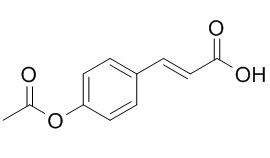4-Acetoxycinnamic acid
Inquire / Order:
manager@chemfaces.com
Technical Inquiries:
service@chemfaces.com
Tel:
+86-27-84237783
Fax:
+86-27-84254680
Address:
1 Building, No. 83, CheCheng Rd., Wuhan Economic and Technological Development Zone, Wuhan, Hubei 430056, PRC
Providing storage is as stated on the product vial and the vial is kept tightly sealed, the product can be stored for up to
24 months(2-8C).
Wherever possible, you should prepare and use solutions on the same day. However, if you need to make up stock solutions in advance, we recommend that you store the solution as aliquots in tightly sealed vials at -20C. Generally, these will be useable for up to two weeks. Before use, and prior to opening the vial we recommend that you allow your product to equilibrate to room temperature for at least 1 hour.
Need more advice on solubility, usage and handling? Please email to: service@chemfaces.com
The packaging of the product may have turned upside down during transportation, resulting in the natural compounds adhering to the neck or cap of the vial. take the vial out of its packaging and gently shake to let the compounds fall to the bottom of the vial. for liquid products, centrifuge at 200-500 RPM to gather the liquid at the bottom of the vial. try to avoid loss or contamination during handling.
Chemistry of Natural Compounds2020, 56,423-426
Molecules2020, 25(4):892
J Sep Sci.2023, 46(16):e2300160.
Plants (Basel).2021, 10(6):1192.
Plants2022, 11(3),294.
Phytother Res.2019, 33(7):1784-1793
J Pharmaceut Biomed2020, 178:112894
Nutr Res Pract2019, 13:e45
FEBS J.2022, 10.1111:febs.16676.
The Journal of Internal Korean Medicine2015, 36(4):486-497
Related and Featured Products
Macromolecules, 2003, 36(20).
Self-Organizing Polycondensation of (E)-4-Acetoxycinnamic Acid for Preparation of Poly(p-oxycinnamoyl) Microspheres.[Reference:
WebLink]
METHODS AND RESULTS:
Preparation of poly(p-oxycinnamoyl) (POC) microspheres was examined by the reaction-induced phase separation of oligomers during the polycondensation of (E)-4-Acetoxycinnamic acid in various solvents. Polymerization in liquid paraffin yielded the microspheres having a smooth surface at 270−330 °C, of which the average diameter was 4.6 μm. In contrast to this, the morphology of the products was drastically changed in Therm S 800 (TS8) and Therm S 900 (TS9) by polymerization temperature. When the polymerization was carried out at 310 °C in TS8 and 300 °C in TS9, the microspheres were obtained, of which the average diameter was 3.9 and 3.3 μm, respectively. The platelike crystals were formed under these temperatures, of which thickness was approximately 0.1 μm. The formation of the microspheres was highly related to the miscibility between the oligomers and the solvents. The average diameter of the microspheres increased with the decrease of the miscibility, and this tendency could be accounted for by the interfacial tension between two immiscible liquid phases.
CONCLUSIONS:
The microspheres were formed through the formation of the microdroplets by the liquid−liquid phase separation of the oligomers and the subsequent solidification of the microdroplets due to the further polymerization in them.



